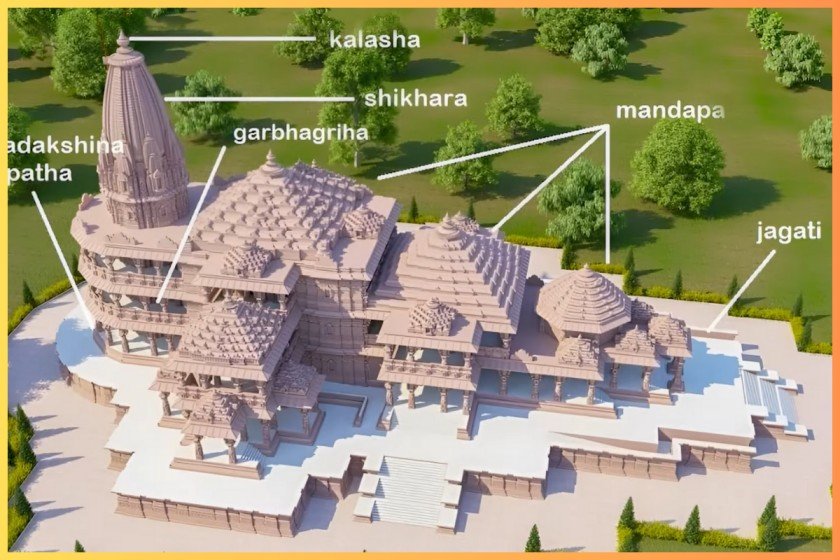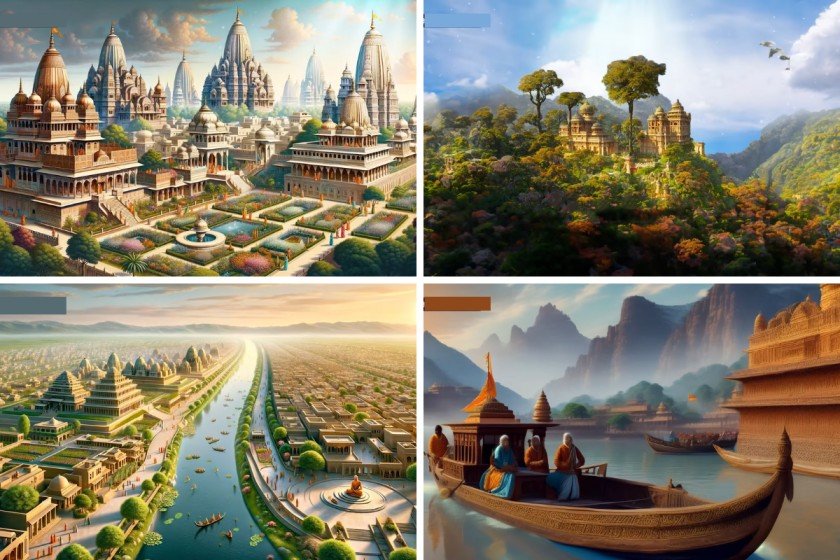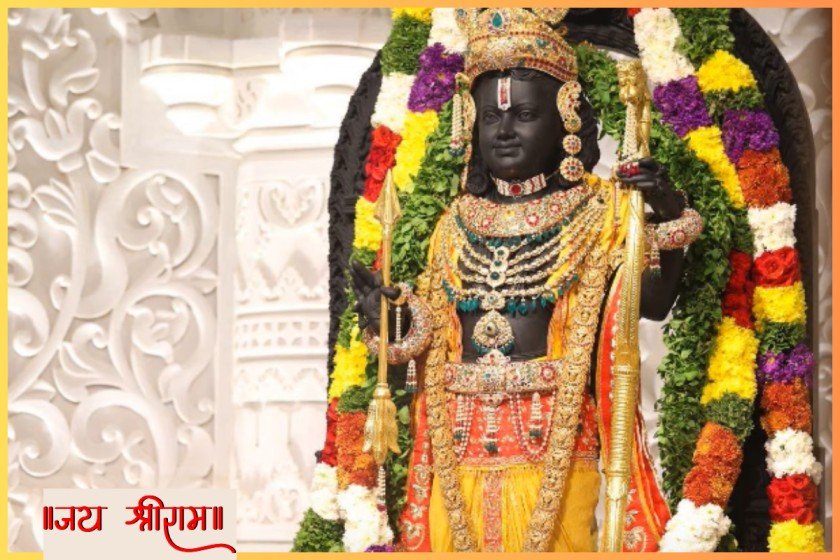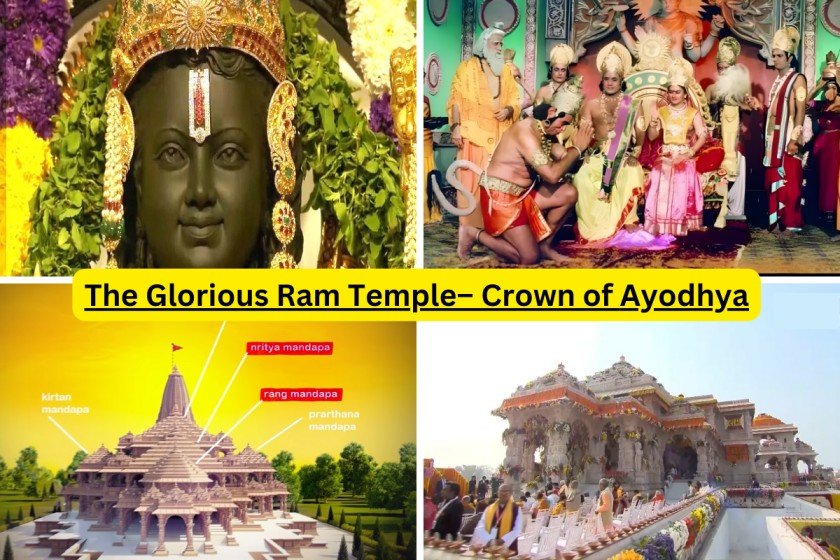Table of Contents
The Glorious Ram Temple– Crown of Ayodhya
Ayodhya, the sacred birthplace of Lord Ram, is undergoing a transformative journey to reclaim its glorious past as one of the world’s most prosperous and beautiful cities. As per the Ramcharitmanas, Ayodhya once boasted splendid structures, grand temples, lush gardens, and a thriving economy that attracted traders from across the globe. After centuries of neglect and destruction, the city’s shine had dimmed. However, a remarkable comeback is underway as the Uttar Pradesh government and the Modi administration have initiated mega infrastructure and beautification projects worth thousands of crores to revamp Ayodhya into a global spiritual hub. These initiatives include the construction of the iconic Ram Mandir, improvements to the riverfront, and upgrades to international connectivity, all contributing to the city’s dramatic transformation.
The crown jewel of Ayodhya’s metamorphosis is the construction of the grand Sri Ram temple, also known as the Ram Janmabhoomi Mandir. Adhering to principles of Vastu Shastra and designed in the Nagara architectural style, this breathtaking stone temple will soar over 160 feet tall and stretch across a vast area of 70 acres. The temple’s exterior and interiors will be adorned with almost 2000 statues, meticulously crafted by specialized artisans to narrate captivating tales from the Ramayana. Once completed in 2024, the Ram Mandir is expected to attract between 3-5 lakh pilgrims daily, making it a significant place of worship and global tourist attraction. In anticipation of this influx of visitors, additional amenities such as locker rooms, hospitals, and language translation services are being developed. The majestic Ram Mandir’s architectural grandeur and spiritual ambiance will undeniably position Ayodhya as a significant sacred site for Hindus worldwide.

Parallelly, Ayodhya’s transport infrastructure has been completely overhauled to accommodate millions of tourists and the city’s growing population. The gleaming new Ayodhya Dham Railway Station, inspired by the under-construction Ram Temple, began operations in December 2022. The station, built with an investment of Rs 240 crores, features three glass-domed Nagara style waiting areas connected via escalators and ramps across three floors, ensuring streamlined transit. The Maharshi Valmiki International Airport, Uttar Pradesh’s eighth functional airport, has also commenced operations. This sustainable airport can initially handle 10 lakh passengers annually. Within Ayodhya, the expansion of wide roads and intersecting paths, including the Laxman Path and Bhakti Path, is improving accessibility across the city. Furthermore, tourists will soon enjoy a sail on the eco-friendly solar-powered Ramayan Cruise, a part of the waterways upgrade, across the serene Sarayu River. To cater to the expected surge in tourists, Ayodhya is enhancing its accommodation facilities by establishing luxury tent cities and budget dharamshalas, offering lodging facilities to thousands of pilgrims.
The government has also partnered with hotel chains like Radisson, Marriott, and OYO, who have started constructing properties. Ayodhya’s revival strategy goes beyond the construction of the grand Ram Mandir. It aims to encapsulate and honor its rich legacy by incorporating elements of the Ramayana across tourist attractions. The city is developing a Ram Katha Gallery, a Ram Katha Park, a Ramayan Cruise, a Ram Statue, a Ram Tirth Kund, a Ramayan Gallery, and the Deepotsav. The Ram Circuit will link all these major temples and heritage sites in Ayodhya, providing pilgrims a devotional route to complete their holy circuit. Simultaneously, extensive infrastructure development is underway to transform Ayodhya into a smart, sustainable city. These projects, part of the government’s Vision 2047 program, include water treatment plants to cleanse the Sarayu river, rainwater harvesting infrastructure, garbage recycling centers, solar energy generation hubs, free citywide WiFi hotspots, multilevel parking complexes, digitized libraries and universities, healthcare center upgrades, and an extensive CCTV security network. Indeed, Ayodhya’s revival goes beyond mere transformation; it is a manifestation of India’s incredibly rich cultural heritage. The city’s progress signifies a promising outlook for Uttar Pradesh, fostering growth, prosperity, and an enhanced quality of life for its residents. This journey is not just local; it symbolizes the successful integration of tradition and progress, forging a path towards a brighter and more inclusive future for all. With every step forward, Ayodhya is not only enhancing India’s global standing but also contributing significantly to the country’s global influence and admiration.

Shri Ram Janmabhoomi Mandir
A significant part of Ayodhya’s transformation is the construction of Shri Ram Janmabhoomi Mandir, a monumental temple that reflects the rich cultural heritage of the city. This magnificent temple, meticulously built according to the principles of Vastu Shastra in the exquisite Nagara architectural style, stands as a shining example of architectural brilliance and craftsmanship.
The temple, along with its sprawling complex spanning an impressive 70 acres, will not only serve as a place of worship but also as a vibrant cultural hub. Within its sacred grounds, visitors will find a collection of exquisitely crafted temples dedicated to various deities associated with the epic Ramayana, creating a spiritual oasis that fosters a deep connection with ancient traditions and beliefs.

Moreover, the temple complex will also serve as a beacon of environmental conservation, with lush gardens and green spaces that promote harmony between nature and spirituality. This commitment to preserving the ecosystem not only adds to the serene ambiance but also showcases Ayodhya’s dedication to sustainable development.
In essence, the Shri Ram Janmabhoomi Mandir and its surrounding complex are not just structures of architectural grandeur, but also symbols of spiritual devotion, cultural richness, and environmental consciousness. They stand as a testament to Ayodhya’s timeless heritage and its vision for a harmonious future.
Improved Accessibility
To cater to the anticipated surge of visitors, Ayodhya’s connectivity has been significantly enhanced. Extensive construction projects are underway, including the development of new highways and ring roads, aiming to facilitate smoother transportation within and around the city. The Ayodhya Dham Junction Railway Station has also undergone a comprehensive revamp, incorporating modern facilities and amenities to ensure a seamless travel experience for passengers. Moreover, in a remarkable stride, the city proudly inaugurated the Maharshi Valmiki International Airport, an international gateway that further boosts Ayodhya’s accessibility on a global scale. Additionally, to enhance waterway transport and promote sustainable travel options, plans are underway to introduce river metro services, which will offer a unique and scenic mode of transportation for both locals and tourists alike. With these ambitious initiatives, Ayodhya is poised to provide a comprehensive and convenient travel infrastructure, ensuring an enjoyable and hassle-free experience for all visitors.
Accommodation
With an estimated daily footfall of 3-5 lakh visitors, accommodation in Ayodhya is undergoing a major upgrade. Tent cities, designed to cater to various budgets and preferences, are being planned to provide a unique and immersive experience for visitors. Alongside these tent cities, numerous hotels are also in the pipeline, ensuring that there will be a wide range of options for every traveler. Moreover, in response to the growing demand, several renowned hotel chains are setting up establishments in Ayodhya, leading to an expected addition of 25,000 hotel rooms in the city. This significant expansion in accommodation facilities will not only enhance the overall experience for tourists but also contribute to the economic growth and development of Ayodhya.

Futuristic Vision of Ayodhya
Ayodhya’s transformation goes beyond just infrastructure development. Alongside the modernization efforts, there are several initiatives aimed at revitalizing the city’s spiritual essence. One such initiative includes the construction of grand entry gates, which will serve as a majestic welcome to visitors. Additionally, a temple museum is being established to showcase the rich history and cultural significance of Ayodhya. As a unique attraction, an Indian version of Disneyland called Ram Land is in the works, where cutting-edge technology will be used to bring the stories of Shri Ram to life. To further elevate the city’s splendor, plans are underway to construct a monumental structure that will surpass the height of the Statue of Unity. These remarkable endeavors will undoubtedly enhance Ayodhya’s grandeur and allure, making it a truly captivating destination for both locals and tourists alike.
Reviving Ramayan Tradition
Ayodhya’s transformation is an awe-inspiring ode to its rich traditions and ancient cultures, showcasing the city’s profound journey through time. As part of this remarkable metamorphosis, the buildings are meticulously adorned with intricate artwork, painted in a vibrant shade of yellow that radiates a sense of unity and vibrancy. The shop shutters, embellished with symbols like the Swastika and Tripunda, serve as a testament to the deep-rooted cultural heritage that permeates every corner of this sacred city.
Drawing inspiration from the epic Ramayan, the flyovers and building walls come alive with captivating paintings that vividly depict the tales of valor and devotion. Every stroke of the brush breathes life into the heroic sagas, evoking a sense of admiration and awe in the hearts of those who behold them. As the sun sets and dusk embraces the city, Ayodhya transforms into a poetic masterpiece, bathed in the soothing glow of thematic street lighting. The warm hues create a mesmerizing ambiance, casting a spell on both residents and visitors and immersing them in the enchanting aura of the city.
Ayodhya’s transformation is not merely a visual delight; it is a testament to the city’s unwavering commitment to preserving its glorious past while embracing a future that shines even brighter. Each brushstroke, each meticulously painted building, and each symbol of cultural heritage tell a story of Ayodhya’s profound connection to its roots and its vision for a more vibrant and promising tomorrow.

Ayodhya: A Solar City
In line with Ayodhya’s rich historical association with the Sun Dynasty, the city is embarking on a remarkable and ambitious transformation into a solar city. With a visionary aim to derive all its electricity from clean and renewable solar power, Ayodhya is poised to become the first truly sustainable and eco-friendly solar city in the state of Uttar Pradesh. This groundbreaking initiative not only highlights Ayodhya’s unwavering commitment to harnessing the potential of renewable energy, but it also serves as a beacon of inspiration for other cities to emulate in their pursuit of a greener, cleaner, and more sustainable future. By embracing solar energy on such a scale, Ayodhya is not only reducing its carbon footprint but also setting a precedent for cities worldwide to follow, as we collectively strive towards a more sustainable and environmentally conscious world.
Impact on Economy
Ayodhya’s transformation is not only stimulating the local economy, but it is also creating numerous job opportunities for the residents. The surge in businesses, ranging from hospitality to retail, has brought about a remarkable boost to the city’s economic landscape. With the increase in commercial activities, Ayodhya is witnessing a rise in infrastructure development, including new shopping centers, office spaces, and improved transportation networks. As a result, real estate prices have witnessed an impressive ten-fold increase, attracting investors and developers alike. This economic boom has not only revitalized the city but also fostered a sense of optimism and pride among its people.
The ongoing development projects in Ayodhya are anticipated to have a far-reaching positive impact on the overall economy of Uttar Pradesh. The growth in industries such as tourism, hospitality, and retail is expected to create a ripple effect, generating employment opportunities in various sectors. This, in turn, will lead to increased consumer spending, driving further economic growth. Additionally, the improved infrastructure and amenities will enhance the quality of life for the residents, providing better healthcare, education, and recreational facilities.
Overall, Ayodhya’s transformation is not just about economic prosperity, but it is also about creating a better future for its people. The city’s progress signifies a promising outlook for Uttar Pradesh, fostering growth, prosperity, and a better quality of life for its residents.

Conclusion
Ayodhya’s revival is not just a mere transformation; it is a magnificent embodiment of India’s incredibly rich and diverse cultural heritage, steeped in centuries of history and deep spiritual foundations. The city’s metamorphosis goes beyond the preservation of its glorious past; it embraces modern infrastructure and sustainable practices, creating a harmonious blend of tradition and progress that resonates with its vibrant community.
As Ayodhya evolves into a world-class city, it stands poised to set an exceptional precedent for urban development, inspiring other cities to follow suit. The transformation encompasses not only its physical aspects but also extends to the intangible realm. The revitalized Ayodhya will serve as a testament to the power of collective vision and tireless efforts, showcasing the immense potential of cultural rejuvenation and urban revitalization.
With every step forward, Ayodhya’s rise will undoubtedly enhance India’s standing on the global stage. It will project the country’s cultural, historical, and spiritual significance to the world, captivating the hearts and minds of people from all walks of life. Ayodhya will become a beacon of India’s soft power, contributing significantly to the country’s global influence and admiration.
This remarkable journey of Ayodhya’s transformation is not just a local endeavor but a testament to the power of cultural heritage and the indomitable spirit of a nation. It symbolizes the seamless integration of tradition and progress, forging a path towards a brighter and more inclusive future for all.
Please Note :- The content of this article has been taken from the YouTube video “How Ram Mandir is Transforming Ayodhya“. We support their efforts. The link of their channel is given below. And Please support both of our efforts.
This Video Link is :- https://www.youtube.com/watch?v=nXegDnmd_iE
FAQS
- How is Ayodhya being upgraded into a world-class Smart City?
Apart from the religious tourism infrastructure, Ayodhya is seeing modern development through various Smart City projects like water treatment plants, rainwater harvesting systems, 150 MLD sewage treatment facilities, waste recycling centers, citywide free WiFi, multilevel parking complexes, upgraded healthcare centers and libraries, solar power hubs, etc. These will enable it to sustain huge visitor volumes with quality utilities meeting global standards. The goal is transforming Ayodhya into a spiritually vibrant yet highly livable modern city.
- What is unique about the architectural style of the under-construction Ram Mandir?
The Ram Janmabhoomi Mandir incorporates distinctive Nagara Hindu temple architectural styling blended with intricate stone carvings by over 200 specialized artisans. It spans over 2.7 acres, standing at 161 feet tall while accommodating idols of other deities besides Ram Lala within its sanctum. The use of intricate pink sandstone workmanship makes this temple stand apart as a one-of-a-kind monument attracting architects globally.
- How will the redeveloped Ramayana Cruise enhance tourism?
The hour-long solar-run Ramayana Cruise boats make for a unique attraction taking visitors along the serene Sarayu River through major Ayodhya ghats like Guptar Ghat, Raj Ghat and Lakshman Ghat which trace Ram’s journey and empire ascent after returning from exile. Tourists get to absorb the spiritual legacy via guided storytelling and performances of iconic episodes on the river journey between faith heritage sites. Airconditioning and refreshments provide comfort.
- What global recognition has the grand Deepotsav festival brought for Ayodhya?
Ayodhya creates two new Guinness World Records through every Deepotsav! In 2022, the Banks of River Saryu were illuminated by a record-breaking 15.76 lakh diyas with a splendid music laser show during the star-studded celebrations, placing the city firmly on global celebrations map. International media houses and tourists specially visit to partake of the glittering Diwali extravaganza.
- How does reimagined Ayodhya aim to boost India’s soft power globally?
Showcasing India’s rich cultural legacy and Hindu spiritual traditions through attractions like the Ram Mandir, Deepotsav and mythological sites spreads awareness worldwide about thriving belief systems drawing overseas visitors beyond usual spots like Vatican City or Mecca. As global citizens eyewitness the structural magnificence and spiritual energy personally in the redeveloped Ayodhya, respect for enduring Indian ethos naturally heightens – elevating the nation’s soft power appeal internationally.
Read Related Article on Tourist:-
The Auspicious Homecoming: Celebrating Ram Lalla Sthapna Diwas 22 Jan 2024
The article announces the upcoming Ram Lalla Sthapna Diwas on January 22nd, 2024, which will commemorate the installation of the Ram Lalla idol in the newly constructed Ram Mandir at the Ram Janmabhoomi site in Ayodhya. Millions of devotees are expected to attend the festivities which will last about a week. Elaborate security and queueing arrangements are being made to manage the huge crowds. The milestone event marks the culmination of a 500-year aspiration to rebuild the temple after previous demolishing invasions. The ceremonies will include rituals like Sudarshan Havan Yagya, Jalabhishek, Ramlala Nom Vidhi performed by high priests, as well as cultural performances. For most devotees, this will be a once-in-a-lifetime experience to participate in Lord Ram’s auspicious homecoming. The grand temple with its intricate design will stand as a symbol of faith, unity and humanity. Its modest central sanctum reflects the compassionate simplicity of Lord Ram’s own legendary life, reminding all of the supremacy of righteous values.
